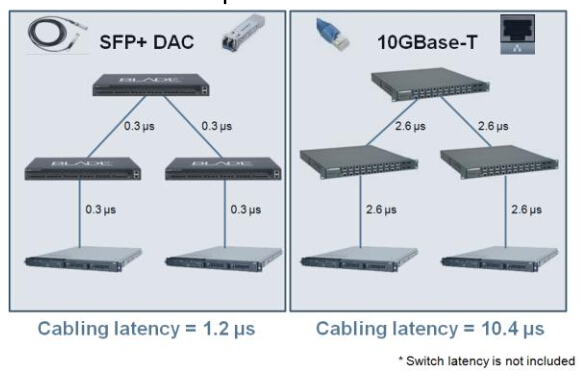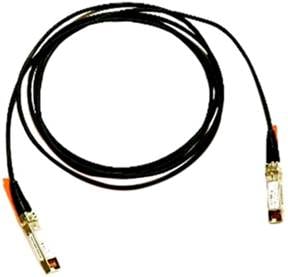10GBASE-T vs SFP+ DAC
Eight years ago, the networking industry was gearing up for massive uptake of copper-based 10 Gigabit Ethernet (GbE) using 10GBase-T. As a result, we are seeing the expansion of higher speed Ethernet solutions, specifically 10 and 40 gigabit Ethernet.
In particular to 10 gigabit Ethernet (10GbE), which is booming with new applications accentuating the differences between Ethernet adapter designs, copper is back on the 10GbE menu. Only now the copper option is in a newer format called SFP+ Direct Attached Twinax copper cable, which uses twin-axial copper cable and plugs into the SFP+ receptacles also used for fibre optics.
These questions were asked by network switch users. Maybe you have the same question. What's the main difference when you choose the 10GBASE-T or SFP+ DAC?
10GBase - T
10GBase - T – IEEE standard 802.3an - 2006 for operation at 10 gigabits per second over Cat 5/6/7 twisted pair cable at distances up to 100 meter. 10GBase-T works at 100 meters for Cat6A or Cat7 cable, and up to 50 meters for Cat6, Cat 5E, or even Cat 5 cable.
In the early days of Ethernet there were several PHY standards, including various forms of coaxial cable, but Ethernet only gained widespread adoption once it was run on twisted pair cable, and as point - to - point rather than an unstructured loop. It became practical to run an Ethernet cable to each desktop alongside the phone cable, and make all the connections in a wire closet. The connector used for twisted pair was the RJ45 connector.
Many IT managers are now evaluating the newly refreshed 10GBase-T technology, as the perception is that 10GBase-T is cheaper and easier to deploy than the alternative SFP+ technologies.
SFP+ DAC
Instead of installing an optical transceiver at each end plus a length of fiber optic cable , a cable was invented with each end physically resembling an SFP+ transceiver, but with none of the expensive electronic components. A small component is required to identify cable type to the SFP+ host, but its cost is negligible. This innovation, call ed either Direct Attach Cable (DAC) or twinax, is a low cost solution for shorter distances, while keeping the high - density equivalent to RJ45 connectors.
The following table compares these two technologies:

Two microseconds may not seem high at first; however, if we imagine a TOR infrastructure where traffic is passing 4 hops to reach the destination, as much as 10.4usec delay is introduced when using 10GBase-T. This is a significant performance penalty compared to using 1.2usec introduced by the SFP+ DAC technology.

The 10GBase-T delay becomes the same order of magnitude as Solid State Disk latency, and therefore dramatically delays data delivery by nearly 50 percent. High latencies in the data center infrastructure results in delays in CPU and application works, therefore limiting data center efficiency and increasing operational costs.
10GBase - T advantages:
- Longer distance - 100 meters vs. 8.5
- Familiar RJ45 connectors and Cat 5/6/7 cables
- Use of patch panels and structured wiring - Backward compatibility to 1 gigabit Ethernet or 100 megabit Ethernet
SFP+ with DAC advantages:
- Significantly lower overall cost, when you include switch, NIC and cable
- Lower latency – 300 ns per hop vs. 2.6 us per hop
- Lower power and lower heat
- Freely intermix fiber and DAC to meet distance requirements
For data centers, the advantages of SFP+ with DAC are a very good match for today’ s requirements and emerging trends. That’s why SFP+ with DAC is being adopted rapidly as best practice for new data centers. For wiring closets, 10GBase - T will be the obvious choice once the demand for bandwidth becomes more acute and once the price and p ower for 10GBase - T technology comes down.
Fiberstore Meida Options for 10 Gigabit Ethernet
 Fiberstore is a professional OEM manufacturer and supplier of optical networking solutions. Cisco compatible SFP+ modules provided by Fiberstore give you a wide variety of 10 Gigabit Ethernet connectivity Meida options for data center, enterprise wiring closet, and service provider transport applications, such as Cisco SFP+ Twinax Copper Cables, Cisco SFP+ active optical cables:
Fiberstore is a professional OEM manufacturer and supplier of optical networking solutions. Cisco compatible SFP+ modules provided by Fiberstore give you a wide variety of 10 Gigabit Ethernet connectivity Meida options for data center, enterprise wiring closet, and service provider transport applications, such as Cisco SFP+ Twinax Copper Cables, Cisco SFP+ active optical cables:
- Cisco SFP-H10GB-CU1M, Up to 10.5G, 1m AWG30, passive copper
- Cisco SFP-H10GB-CU1-5M, Up to 10.5G, 1.5m; AWG30, passive copper
- Cisco SFP-H10GB-CU2M, Up to 10.5G, 2m; AWG30, passive copper
- Cisco SFP-H10GB-CU3M, Up to 10.5G, 3m; AWG30, passive copper
- Cisco SFP-H10GB-CU5M, Up to 10.5G, 5m; AWG24, passive copper
- Cisco SFP-10G-AOC1M, SFP+ AOC, fiber, 10G, 1m
- Cisco SFP-10G-AOC3M, SFP+ AOC, fiber, 10G, 3m